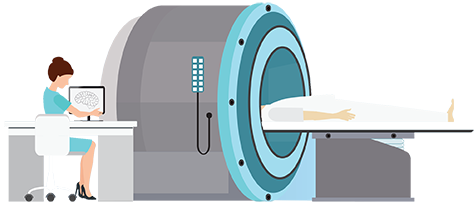

Radiologic Technologists can operate in a wide variety of settings from emergency room and trauma assistance, bedside, or in a standard medical imaging facility. Jobs are available most commonly in hospitals and medical imaging centers, but also in physician offices, veterinary offices, and dental practices. The types of procedures performed are many and the radiologic technologist job description may vary depending upon the size and scope of the facility. Some of the most common include CT (Computed Tomography), MRI (Magnetic Resonance Imaging), and Ultrasound (Diagnostic Medical Sonography). To view a more comprehensive resource on the various modalities and specializations, visit our radiology specializations page.
Radiologic Technologists, also known as Rad Tech’s or RT’s, assist the Radiologist physician with the process of imaging and diagnosing illness. Radiologic Technologist job descriptions include tasks such as: capturing the image, obtaining the best quality image, and ensuring the patients are comfort and safe. The RT; however, does not do the actual diagnosing as this is the function of the physician or Radiologist M.D. The Rad Tech must be able to effectively explain the procedure to the patient and be sure that they are comfortable and at ease during the procedure; however, it is very important that they do what is necessary to obtain a high quality image that will be sufficient for thorough examination by the physician and allow for correct diagnosis.
Positioning a patient for an exam may sound simple; however, it is commonly known among RT’s that patient positioning can be challenging for a number of reasons. The patients may be sick and at different levels of severity of illness. They may have trouble maintaining the position needed to get the best quality image because of their illness or simply because they are elderly or handicapped. Other reasons include patient anxiety or even anger about the possibility that they have an illness. A major part of the radiologic technologist job description is to have strength of character to work through these challenges with the patient in a calm, compassionate, and professional demeanor. After all, it is in the best interest of the patient to get the best quality images taken to aid in their road to recovery. As an RT, you will have a full understanding of the protocols and requirements of positioning depending on what the specific case warrants and what the ordering physician has requested.
To prevent unnecessary exposure to radiation during certain procedures, an RT will use protective devices such as lead shields. The amount of radiation you exposure yourself to is documented and tested on an ongoing basis to ensure that there will be no adverse side effects to you. Patients are of course, also protected from radiation exposure and there are strict protocols for the amount of radiation used depending on the type of procedure being performed. Different organs and tissues within the body have various levels of sensitivity to radiation. Rad Tech’s are trained to understand this and to adjust radiation levels and precautionary measures according to radiology-info.org.